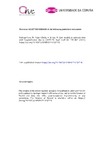Mostrar o rexistro simple do ítem
Cure models to estimate time until hospitalization due to COVID-19
| dc.contributor.author | Pedrosa-Laza, Maria | |
| dc.contributor.author | López-Cheda, Ana | |
| dc.contributor.author | Cao, Ricardo | |
| dc.date.accessioned | 2023-12-26T12:06:10Z | |
| dc.date.available | 2023-12-26T12:06:10Z | |
| dc.date.issued | 2022-01 | |
| dc.identifier.citation | Pedrosa-Laza, M., López-Cheda, A. & Cao, R. Cure models to estimate time until hospitalization due to COVID-19. Appl Intell 52, 794–807 (2022). https://doi.org/10.1007/s10489-021-02311-8 | es_ES |
| dc.identifier.issn | 1573-7497 | |
| dc.identifier.uri | http://hdl.handle.net/2183/34641 | |
| dc.description | This version of the article has been accepted for publication, after peer review and is subject to Springer Nature’s AM terms of use, but is not the Version of Record and does not reflect post-acceptance improvements, or any corrections. The Version of Record is available online at: https://doi.org/10.1007/s10489-021-02311-8 | es_ES |
| dc.description.abstract | [Abstract]: A short introduction to survival analysis and censored data is included in this paper. A thorough literature review in the field of cure models has been done. An overview on the most important and recent approaches on parametric, semiparametric and nonparametric mixture cure models is also included. The main nonparametric and semiparametric approaches were applied to a real time dataset of COVID-19 patients from the first weeks of the epidemic in Galicia (NW Spain). The aim is to model the elapsed time from diagnosis to hospital admission. The main conclusions, as well as the limitations of both the cure models and the dataset, are presented, illustrating the usefulness of cure models in this kind of studies, where the influence of age and sex on the time to hospital admission is shown. | es_ES |
| dc.description.sponsorship | MPL activity was funded by the Science, Technology, and Innovation Plan of the Principality of Asturias (Spain) Ref: FC-GRUPIN-IDI/2018/000225, which is part-funded by the European Regional Development Fund (ERDF). ALC was sponsored by the BEATRIZ GALINDO JUNIOR Spanish Grant from MICINN (Ministerio de Ciencia, Innovación y Universidades) with reference BGP18/00154. RC and ALC acknowledge partial support by the MINECO grant MTM2017-82724-R, and by the Xunta de Galicia: Grupos de Referencia Competitiva ED431C-2020-14, Centro de Investigación del Sistema universitario de Galicia ED431G 2019/01, and Axencia Galega de Innovación (Ayudas proyectos de investigación COVID-19 presentados a la convocatoria del ISCIII IN845D 2020/26 - Programa Operativo FEDER Galicia 2014-2020), all of them through the ERDF. | es_ES |
| dc.description.sponsorship | Gobierno del Principado de Asturias; FC-GRUPIN-IDI/2018/000225 | es_ES |
| dc.description.sponsorship | Xunta de Galicia; ED431C-2020-14 | es_ES |
| dc.description.sponsorship | Xunta de Galicia; ED431G 2019/01 | es_ES |
| dc.language.iso | eng | es_ES |
| dc.publisher | Springer Nature | es_ES |
| dc.relation | info:eu-repo/grantAgreement/AEI/Plan Estatal de Investigación Científica y Técnica y de Innovación 2017-2020/MTM2017-82724-R/ES/INFERENCIA ESTADISTICA FLEXIBLE PARA DATOS COMPLEJOS DE GRAN VOLUMEN Y DE ALTA DIMENSION | es_ES |
| dc.relation.uri | https://doi.org/10.1007/s10489-021-02311-8 | es_ES |
| dc.rights | © The Author(s), under exclusive licence to Springer Science+Business Media, LLC, part of Springer Nature 2021 | es_ES |
| dc.subject | Censored data | es_ES |
| dc.subject | COVID-19 | es_ES |
| dc.subject | Hospital demand | es_ES |
| dc.subject | Forecasting | es_ES |
| dc.subject | Survival analysis | es_ES |
| dc.title | Cure models to estimate time until hospitalization due to COVID-19 | es_ES |
| dc.type | info:eu-repo/semantics/article | es_ES |
| dc.rights.access | info:eu-repo/semantics/openAccess | es_ES |
| UDC.journalTitle | Applied Intelligence | es_ES |
| UDC.volume | 52 | es_ES |
| UDC.startPage | 794 | es_ES |
| UDC.endPage | 807 | es_ES |
Ficheiros no ítem
Este ítem aparece na(s) seguinte(s) colección(s)
-
GI-MODES - Artigos [122]






